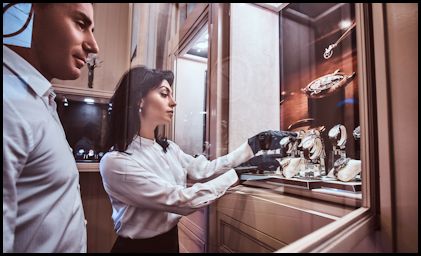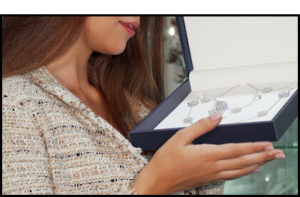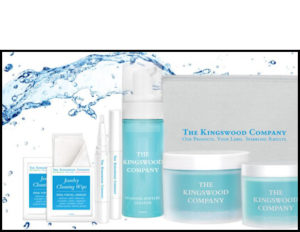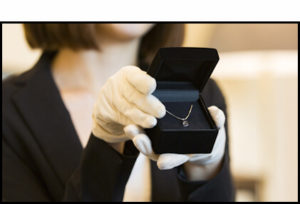Communication is Key in Covid Times

Your staff and customers need to feel safe, welcome and heard.
As you return to business and welcome back customers in your store, you’ll want to be clear and transparent about the steps you are taking to alleviate concerns, advocates Jewelers of America (JA) in its Back to Basics Toolkit for jewelry retailers. Your staff and customers don’t need to just be safe in your store; they need to feel safe, welcome and heard.
JA strongly encourages jewelers to communicate messaging that reflects best practices for conducting business with honesty, integrity, and transparency; respect for the fundamental human rights of all employees, business partners and customers; commitment to high standards of health and safety; and give back in the community in which they do business.
 Because details surrounding COVID-19 are changing so rapidly, stay connected with customers and staff frequently with information that is relevant to your business, advocates JA. Keep your messaging focused and on point. If you implement new safety procedures, explain them directly.
Because details surrounding COVID-19 are changing so rapidly, stay connected with customers and staff frequently with information that is relevant to your business, advocates JA. Keep your messaging focused and on point. If you implement new safety procedures, explain them directly.
JA advocates jewelers post store hours, appointment options and health and safety policy on their website, social media, and throughout the store. Email customers regarding reopening and what is being done to ensure safety. Update the store’s voicemail with store hours and alert callers to new protocols in place to provide a safe shopping experience.
Everyone is processing this crisis differently. Some customers will return without reservations, while others are nervous to leave their homes. Retail consultant Kate Peterson, president of Performance Concepts, Montgomery Village, Maryland tells jewelers to be prepared for whatever they might hear. “We really don’t know what others have experienced.”
Communicate calmly, compassionately and in a voice that is authentically yours. Let customers know what to expect in advance, then again in more detail once in store. Make sure that customers know and can see the effort you are making through signage and communications, as well as visible actions like hand washing and cleaning the merchandise and cases in store.
Culture is Brand
People will make choices about where to do business based on compatibility with their priorities and values. Your  internal culture must match your external brand promise, says Peterson.
internal culture must match your external brand promise, says Peterson.
“Most businesses and industries used to be like black boxes,” she describes. “For the most part, no one could see inside. The brand or the industry was whatever those inside the box painted on the outward-facing walls. People could come and look at the brand or product. They either liked it, or they didn’t.”
Today, our industry, and your business, is a glass box, defines Peterson. “People can see inside. They can see the people, the processes, and the values at work. In other words, they can see your internal culture. Once people can see that culture, they will feel something about it. Your internal culture will become part of your public-facing brand, perhaps the most important part. That’s a shift with massive implications. If there’s disconnect between your internal culture and brand, it will be exposed, and people are far less likely to be tolerant of it today.”
Experts predict that this crisis will dramatically change relationship dynamics. “Constant, close proximity to our family members, the lack of routine, and the temporary closure of churches and other social support structures are major factors in shifting relationship dynamics,” says Peterson. “Rituals and routines have shaped relationships for thousands of years. On average, you and I execute more than 350 rituals and routines daily. The latest estimates indicate that we’ve changed 40 percent of these habits due to the crisis.”
 Clean Habits
Clean Habits
Perhaps the biggest habit we don’t want to change for people is wearing jewelry. Kristie Nicolosi, president and CEO of The Kingswood Company, manufacturer of private label jewelry care products, says many of us have not been wearing much jewelry shuttered at home the past few months. She also cites that 82 percent of consumers say they have jewelry they don’t wear because it’s dirty.
“Jewelers have an opportunity to incorporate a new level of CLEAN into their communications and customer experience,” advocates Nicolosi. She encourages jewelers to include jewelry care and cleaning in every transaction in a post-COVID selling environment.
Jewelry care education is a natural way to connect with customers, especially now when we’re heightened about keeping things really clean. She encourages jewelers to develop a strong social media strategy that shares care tips and information about what clean jewelry means in COVID times.
Invite customers in for a free cleaning, but plan for turnaround time and impact on sales associates, advises Nicolosi. Peterson concurs that service-focused outreach is an effective, non-invasive strategy for client engagement, like ring sizing (for those who gained weight while sheltering in place) and earring replacement (for those who lost an earring in a favorite pair to the elastic band of a facemask). Communicate solutions for customers.
“We are in the people business and quality relationships are critical to our success,” says Peterson. Client Relationship Management (CRM) that is ongoing and developed through quality customer communication will be  even more important now than ever before.
even more important now than ever before.
Empower employees with customer data. If store associates have access to customer data generated both offline and online (data on loyalty and purchase behavior across channels), they can tailor their customer interactions accordingly. Even customers that start and end their journeys online can then receive personalized attention in stores.










